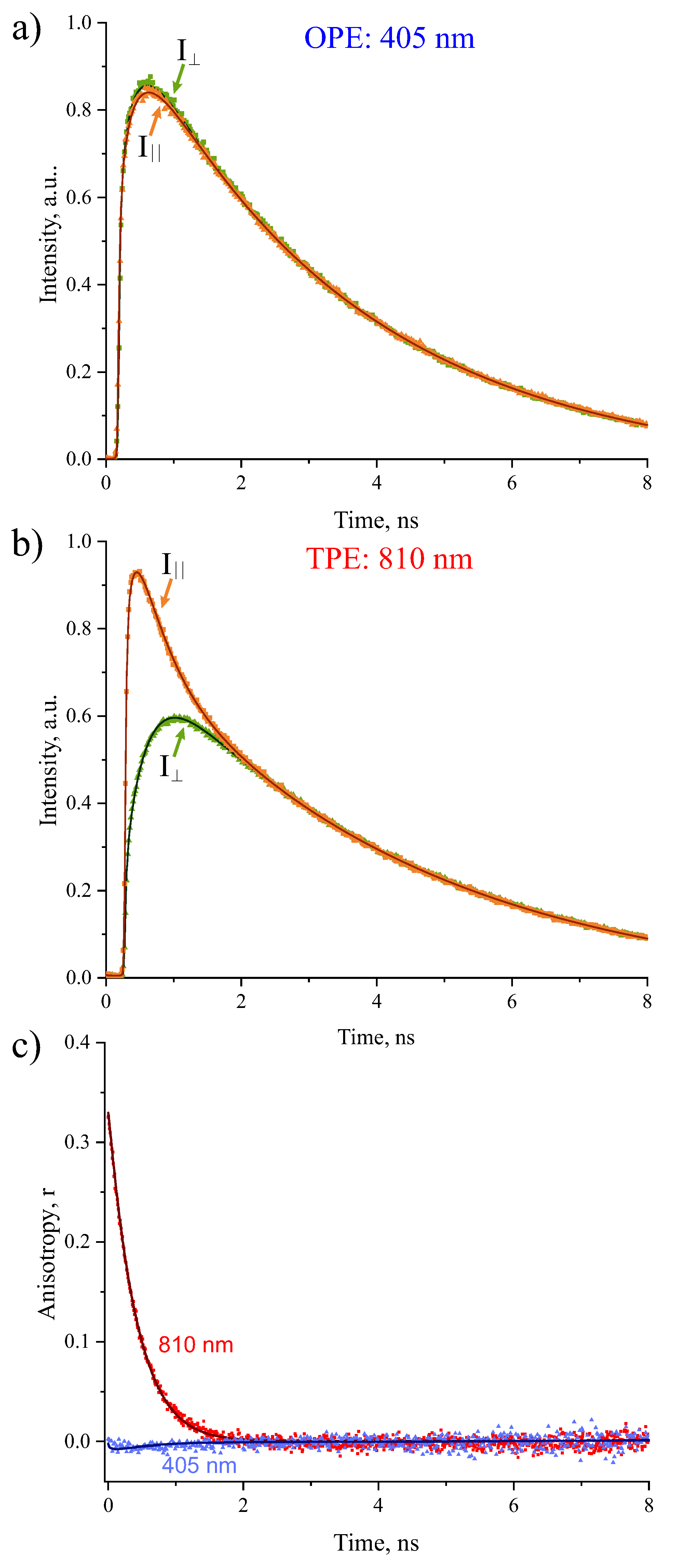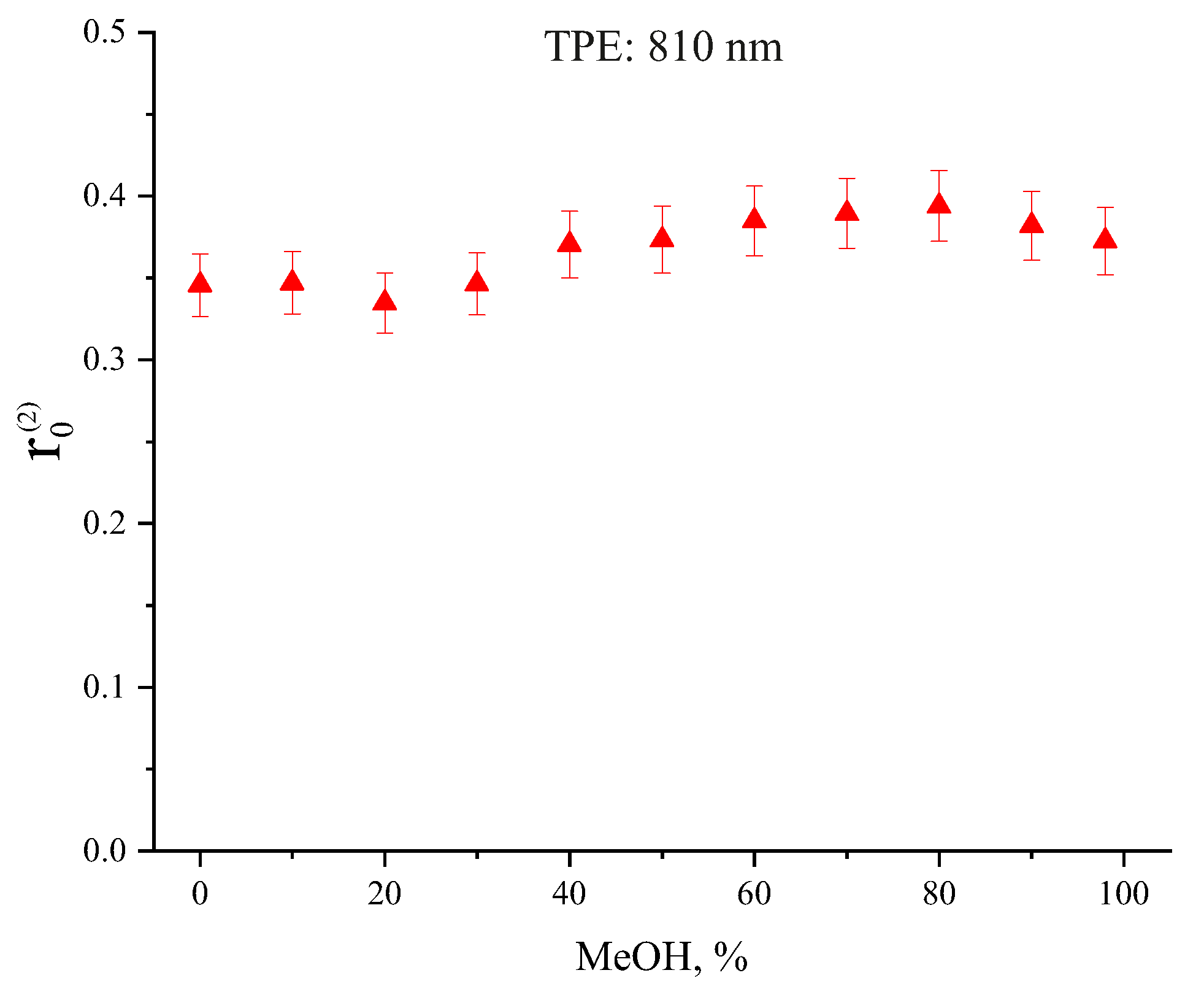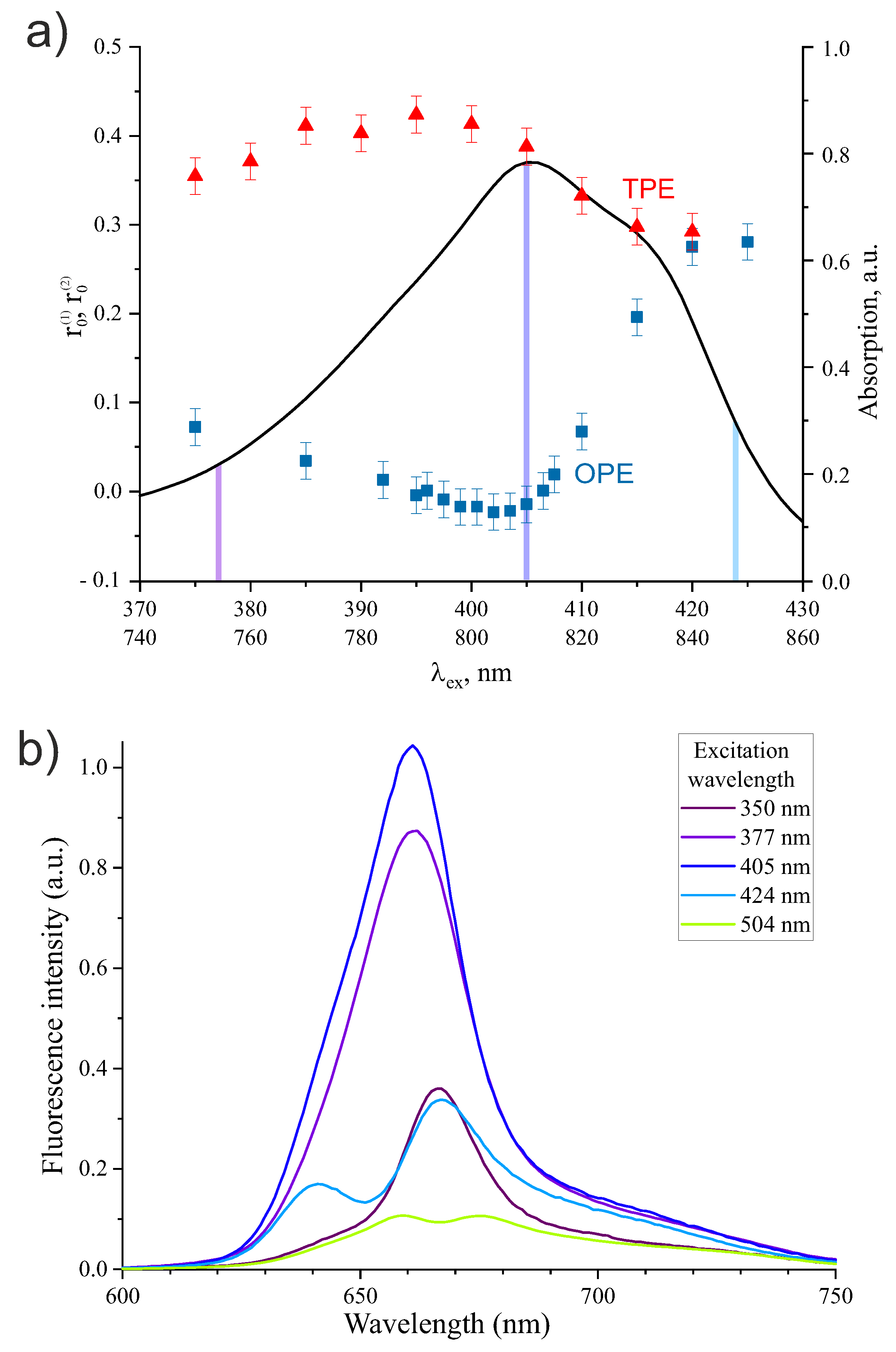Fluorescence Anisotropy in Radachlorin and Chlorin e6 in Water–Methanol Solutions under One- and Two-Photon Excitation
Abstract
1. Introduction
2. Materials and Methods
2.1. Materials
2.2. Time-Resolved Fluorescence Polarization Spectroscopy
2.3. Experimental Data Processing
3. Results and Discussion
3.1. Fluorescence Parameters of Radachlorin under OPE and TPE Modes
3.2. Spectral Dependence of Radachlorin Fluorescence Anisotropy
3.3. Comparative Analysis of Fluorescence Anisotropy of Radachlorin and Chlorin e6
4. Conclusions
Author Contributions
Funding
Data Availability Statement
Acknowledgments
Conflicts of Interest
References
- Sarbadhikary, P.; George, B.P.; Abrahamse, H. Recent advances in photosensitizers as multifunctional theranostic agents for imaging-guided photodynamic therapy of cancer. Theranostics 2021, 11, 9054. [Google Scholar] [CrossRef] [PubMed]
- He, J.; Yang, L.; Yi, W.; Fan, W.; Wen, Y.; Miao, X.; Xiong, L. Combination of fluorescence-guided surgery with photodynamic therapy for the treatment of cancer. Mol. Imaging 2017, 16, 1536012117722911. [Google Scholar] [CrossRef] [PubMed]
- Oliveira, C.S.; Turchiello, R.; Kowaltowski, A.J.; Indig, G.L.; Baptista, M.S. Major determinants of photoinduced cell death: Subcellular localization versus photosensitization efficiency. Free Radic. Biol. Med. 2011, 51, 824–833. [Google Scholar] [CrossRef] [PubMed]
- Kessel, D.; Oleinick, N.L. Cell death pathways associated with photodynamic therapy: An update. Photochem. Photobiol. 2018, 94, 213–218. [Google Scholar] [CrossRef] [PubMed]
- James, N.S.; Cheruku, R.R.; Missert, J.R.; Sunar, U.; Pandey, R.K. Measurement of cyanine dye photobleaching in photosensitizer cyanine dye conjugates could help in optimizing light dosimetry for improved photodynamic therapy of cancer. Molecules 2018, 23, 1842. [Google Scholar] [CrossRef]
- Sheng, C.; Jack Hoopes, P.; Hasan, T.; Pogue, B.W. Photobleaching-based dosimetry predicts deposited dose in ALA-PpIX PDT of rodent esophagus. Photochem. Photobiol. 2007, 83, 738–748. [Google Scholar] [CrossRef]
- Georgakoudi, I.; Nichols, M.G.; Foster, T.H. The mechanism of Photofrin photobleaching and its consequences for photodynamic dosimetry. Photochem. Photobiol. 1997, 65, 135–144. [Google Scholar] [CrossRef]
- Zhikhoreva, A.; Belashov, A.; Belyaeva, T.; Salova, A.; Litvinov, I.; Kornilova, E.; Semenova, I.; Vasyutinskii, O. Comparative analysis of Radachlorin accumulation, localization, and photobleaching in three cell lines by means of holographic and fluorescence microscopy. Photodiagn. Photodyn. Ther. 2022, 39, 102973. [Google Scholar] [CrossRef]
- Reshetov, V.; Zorina, T.; D’Hallewin, M.A.; Bolotina, L.; Zorin, V. Fluorescence methods for detecting the kinetics of photosensitizer release from nanosized carriers. J. Appl. Spectrosc. 2011, 78, 103–109. [Google Scholar] [CrossRef]
- Chakrabarty, A.; Mallick, A.; Haldar, B.; Das, P.; Chattopadhyay, N. Binding interaction of a biological photosensitizer with serum albumins: A biophysical study. Biomacromolecules 2007, 8, 920–927. [Google Scholar] [CrossRef]
- Das, K.; Smirnov, A.V.; Wen, J.; Miskovsky, P.; Petrich, J.W. Photophysics of hypericin and hypocrellin A in complex with subcellular components: Interactions with human serum albumin. Photochem. Photobiol. 1999, 69, 633–645. [Google Scholar] [CrossRef] [PubMed]
- Calleja, V.; Ameer-Beg, S.M.; Vojnovic, B.; Woscholski, R.; Downward, J.; Larijani, B. Monitoring conformational changes of proteins in cells by fluorescence lifetime imaging microscopy. Biochem. J. 2003, 372, 33–40. [Google Scholar] [CrossRef] [PubMed]
- Denicke, S.; Gericke, K.H.; Smolin, A.G.; Shternin, P.S.; Vasyutinskii, O.S. Dynamics of two-color two-photon excited fluorescence of p-terphenyl: Determination and analysis of the molecular parameters. J. Phys. Chem. A 2010, 114, 9681–9692. [Google Scholar] [CrossRef] [PubMed]
- Gorbunova, I.A.; Sasin, M.E.; Rubayo-Soneira, J.; Smolin, A.G.; Vasyutinskii, O.S. Two-Photon Excited Fluorescence Dynamics in NADH in Water–Methanol Solutions: The Role of Conformation States. J. Phys. Chem. B 2020, 124, 10682–10697. [Google Scholar] [CrossRef] [PubMed]
- Gorbunova, I.A.; Sasin, M.E.; Golyshev, D.P.; Semenov, A.A.; Smolin, A.G.; Beltukov, Y.M.; Vasyutinskii, O.S. Two-photon excited fluorescence dynamics in enzyme-bound NADH: The heterogeneity of fluorescence decay times and anisotropic relaxation. J. Phys. Chem. B 2021, 125, 9692–9707. [Google Scholar] [CrossRef]
- Beltukova, D.M.; Belik, V.P.; Semak, B.V.; Semenova, I.V.; Smolin, A.G.; Vasyutinskii, O.S. Relaxation dynamics of alkyl derivatives of fluorescein MitoFluo and C8-Fl in solutions with liposomes. Spectrochim. Acta Part A Mol. Biomol. Spectrosc. 2021, 263, 120145. [Google Scholar] [CrossRef]
- Jordan, A.N.; Das, S.; Siraj, N.; De Rooy, S.L.; Li, M.; El-Zahab, B.; Chandler, L.; Baker, G.A.; Warner, I.M. Anion-controlled morphologies and spectral features of cyanine-based nanoGUMBOS–an improved photosensitizer. Nanoscale 2012, 4, 5031–5038. [Google Scholar] [CrossRef]
- Varma, R.; Mayor, S. GPI-anchored proteins are organized in submicron domains at the cell surface. Nature 1998, 394, 798–801. [Google Scholar] [CrossRef]
- Zheng, W.; Li, D.; Qu, J.Y. Monitoring changes of cellular metabolism and microviscosity in vitro based on time-resolved endogenous fluorescence and its anisotropy decay dynamics. J. Biomed. Opt. 2010, 15, 037013. [Google Scholar] [CrossRef]
- Gorbunova, I.A.; Sasin, M.E.; Beltukov, Y.M.; Semenov, A.A.; Vasyutinskii, O.S. Anisotropic relaxation in NADH excited states studied by polarization-modulation pump–probe transient spectroscopy. Phys. Chem. Chem. Phys. 2020, 22, 18155–18168. [Google Scholar] [CrossRef]
- Lakowicz, J.R. Principles of Fluorescence Spectroscopy; Springer: Berlin/Heidelberg, Germany, 2006. [Google Scholar]
- Kierdaszuk, B.; Gryczynski, I.; Lakowicz, J.R. Two-photon induced fluorescence of proteins. In Topics in Fluorescence Spectroscopy; Springer: Berlin/Heidelberg, Germany, 2002; pp. 187–209. [Google Scholar]
- Brasselet, S.; Ferrand, P.; Kress, A.; Wang, X.; Ranchon, H.; Gasecka, A. Imaging molecular order in cell membranes by polarization-resolved fluorescence microscopy. In Fluorescent Methods to Study Biological Membranes; Springer Series on Fluorescence; Springer: Berlin/Heidelberg, Germany, 2012; pp. 311–337. [Google Scholar]
- Vishwasrao, H.D.; Trifilieff, P.; Kandel, E.R. In vivo imaging of the actin polymerization state with two-photon fluorescence anisotropy. Biophys. J. 2012, 102, 1204–1214. [Google Scholar] [CrossRef] [PubMed]
- Vinegoni, C.; Dubach, J.M.; Feruglio, P.F.; Weissleder, R. Two-photon fluorescence anisotropy microscopy for imaging and direct measurement of intracellular drug target engagement. IEEE J. Sel. Top. Quantum Electron. 2015, 22, 179–185. [Google Scholar] [CrossRef] [PubMed]
- Suhling, K.; French, P.M.; Phillips, D. Time-resolved fluorescence microscopy. Photochem. Photobiol. Sci. 2005, 4, 13–22. [Google Scholar] [CrossRef] [PubMed]
- Cao, Z.; Huang, C.C.; Tan, W. Nuclease resistance of telomere-like oligonucleotides monitored in live cells by fluorescence anisotropy imaging. Anal. Chem. 2006, 78, 1478–1484. [Google Scholar] [CrossRef]
- Foster, T.H.; Pearson, B.D.; Mitra, S.; Bigelow, C.E. Fluorescence anisotropy imaging reveals localization of meso-tetrahydroxyphenyl chlorin in the nuclear envelope. Photochem. Photobiol. 2005, 81, 1544–1547. [Google Scholar] [CrossRef]
- Lobanov, O.I.; Arjantsev, S.Y.; Koroteev, N.I. Time-resolved fluorescence polarization microspectroscopy of photosensitizers in a single living cell. Proc. SPIE 1994, 2083, 117–123. [Google Scholar]
- Beaton, S.; McPherson, R.; Tilley, L. Alterations in erythrocyte band 3 organization induced by the photosensitizer, hematoporphyrin derivative. Photochem. Photobiol. 1995, 62, 353–355. [Google Scholar] [CrossRef]
- Roeder, B.; Wabnitz, H. Time-resolved fluorescence spectroscopy of hematoporphyrin, mesoporphyrin, pheophorbide a and chlorin e6 in ethanol and aqueous solution. J. Photochem. Photobiol. Biol. 1987, 1, 103–113. [Google Scholar] [CrossRef]
- Kelbauskas, L.; Dietel, W. Internalization of Aggregated Photosensitizers by Tumor Cells: Subcellular Time-resolved Fluorescence Spectroscopy on Derivatives of Pyropheophorbide-a Ethers and Chlorin e6 under Femtosecond One-and Two-photon Excitation. Photochem. Photobiol. 2002, 76, 686–694. [Google Scholar] [CrossRef]
- Parkhats, M.V.; Knyukshto, V.N.; Isakau, H.A.; Petrov, P.T.; Dzhagarov, B.M. Photophysical properties of photosensitizer chlorin e6 incorporated into polyvinylpyrrolidone. Proc. SPIE 2007, 6727, 343–348. [Google Scholar]
- Ferreira, J.; Menezes, P.F.C.; Kurachi, C.; Sibata, C.; Allison, R.R.; Bagnato, V.S. Photostability of different chlorin photosensitizers. Laser Phys. Lett. 2008, 5, 156–161. [Google Scholar] [CrossRef]
- Douillard, S.; Lhommeau, I.; Olivier, D.; Patrice, T. In vitro evaluation of Radachlorin sensitizer for photodynamic therapy. J. Photochem. Photobiol. Biol. 2010, 98, 128–137. [Google Scholar] [CrossRef] [PubMed]
- Belik, V.P.; Gadzhiev, I.M.; Petrenko, M.V.; Petrov, M.A.; Semenova, I.V.; Vasyutinskii, O.S. Visible to near IR luminescence spectrum of Radachlorin under excitation at 405 nm. Chem. Phys. Lett. 2016, 665, 127–130. [Google Scholar] [CrossRef]
- Beltukova, D.M.; Semenova, I.V.; Smolin, A.G.; Vasyutinskii, O. Kinetics of photobleaching of Radachlorin photosensitizer in aqueous solutions. Chem. Phys. Lett. 2016, 662, 127–131. [Google Scholar] [CrossRef]
- Zhikhoreva, A.; Belashov, A.; Ignatov, E.; Gelfond, M.; Semenova, I.; Vasyutinskii, O. Singlet oxygen generation in aerosol jet and on biological surfaces. J. Photochem. Photobiol. B Biol. 2022, 228, 112395. [Google Scholar] [CrossRef]
- Sasin, M.E.; Smolin, A.G.; Gericke, K.H.; Tokunaga, E.; Vasyutinskii, O.S. Fluorescence anisotropy in indole under two-photon excitation in the spectral range 385–510 nm. Phys. Chem. Chem. Phys. 2018, 20, 19922–19931. [Google Scholar] [CrossRef]
- Gorbunova, I.A.; Danilova, M.K.; Sasin, M.E.; Belik, V.P.; Golyshev, D.P.; Vasyutinskii, O.S. Determination of fluorescence quantum yields and decay times in NADH and FAD in water-alcohol mixtures: The analysis of radiative and nonradiative relaxation pathways. J. Photochem. Photobiol. A Chem. 2023, 436, 114388. [Google Scholar] [CrossRef]
- Spikes, J.D.; Bommer, J.C. Photobleaching of mono-L-aspartyl chlorin e6 (NPe6): A candidate sensitizer for the photodynamic therapy of tumors. Photochem. Photobiol. 1993, 58, 346–350. [Google Scholar] [CrossRef]
- Reifenberger, J.G.; Snyder, G.E.; Baym, G.; Selvin, P.R. Emission Polarization of Europium and Terbium Chelates. J. Phys. Chem. B 2003, 107, 12862–12873. [Google Scholar] [CrossRef]
- Valeur, B. Molecular Fluorescence: Principles and Applications; Wiley-VCH: Hoboken, NJ, USA, 2022. [Google Scholar]
- Callis, P.R. On the theory of two-photon induced fluorescence anisotropy with application to indoles. J. Chem. Phys. 1993, 99, 27–37. [Google Scholar] [CrossRef]
- Herbrich, S.; Al-Hadhuri, T.; Gericke, K.H.; Shternin, P.S.; Smolin, A.G.; Vasyutinskii, O.S. Two-color two-photon excited fluorescence of indole: Determination of wavelength-dependent molecular parameters. J. Chem. Phys. 2015, 142, 024310. [Google Scholar] [CrossRef] [PubMed]
- Jameson, D.M.; Croney, J.C. Fluorescence polarization: Past, present and future. Comb. Chem. High Throughput Screen. 2003, 6, 167–176. [Google Scholar] [CrossRef] [PubMed]






| Radachlorin | Chlorin e6 | |||||
|---|---|---|---|---|---|---|
| Water | 40% MeOH | 40% MeOH | ||||
| OPE, 405 nm | TPE, 810 nm | OPE, 405 nm | TPE, 810 nm | OPE, 405 nm | TPE, 810 nm | |
| 0.35, ns | 3.3 | 3.5 | 3.5 | 3.8 | 3.8 | 3.8 |
| 0.07, ns | 0.32 | 0.24 | 0.44 | 0.34 | 0.45 | 0.32 |
| 0.02, ns | −0.03 | 0.35 | −0.02 | 0.39 | 0.02 | 0.37 |
Disclaimer/Publisher’s Note: The statements, opinions and data contained in all publications are solely those of the individual author(s) and contributor(s) and not of MDPI and/or the editor(s). MDPI and/or the editor(s) disclaim responsibility for any injury to people or property resulting from any ideas, methods, instructions or products referred to in the content. |
© 2022 by the authors. Licensee MDPI, Basel, Switzerland. This article is an open access article distributed under the terms and conditions of the Creative Commons Attribution (CC BY) license (https://creativecommons.org/licenses/by/4.0/).
Share and Cite
Gorbunova, I.A.; Sasin, M.E.; Zhikhoreva, A.A.; Belashov, A.V.; Beltukova, D.M.; Semenova, I.V.; Vasyutinskii, O.S. Fluorescence Anisotropy in Radachlorin and Chlorin e6 in Water–Methanol Solutions under One- and Two-Photon Excitation. Photonics 2023, 10, 9. https://doi.org/10.3390/photonics10010009
Gorbunova IA, Sasin ME, Zhikhoreva AA, Belashov AV, Beltukova DM, Semenova IV, Vasyutinskii OS. Fluorescence Anisotropy in Radachlorin and Chlorin e6 in Water–Methanol Solutions under One- and Two-Photon Excitation. Photonics. 2023; 10(1):9. https://doi.org/10.3390/photonics10010009
Chicago/Turabian StyleGorbunova, Ioanna A., Maxim E. Sasin, Anna A. Zhikhoreva, Andrey V. Belashov, Dina M. Beltukova, Irina V. Semenova, and Oleg S. Vasyutinskii. 2023. "Fluorescence Anisotropy in Radachlorin and Chlorin e6 in Water–Methanol Solutions under One- and Two-Photon Excitation" Photonics 10, no. 1: 9. https://doi.org/10.3390/photonics10010009
APA StyleGorbunova, I. A., Sasin, M. E., Zhikhoreva, A. A., Belashov, A. V., Beltukova, D. M., Semenova, I. V., & Vasyutinskii, O. S. (2023). Fluorescence Anisotropy in Radachlorin and Chlorin e6 in Water–Methanol Solutions under One- and Two-Photon Excitation. Photonics, 10(1), 9. https://doi.org/10.3390/photonics10010009






